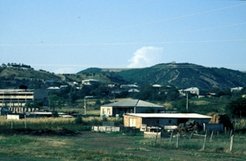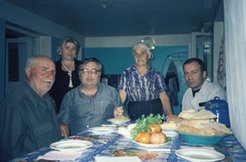Land reform in two former republics of the Soviet Union: Georgia and Ukraine
Land reform in two former republics of the Soviet Union: Georgia and Ukraine
Case Study
In the Kaheti Region (east Georgia), I visited the village of Patardzevli, in the district of Sakarego. This village has 1578 households (with a total population of approximately 3 000). The total land of the village is 4 000 ha, of which 1381 ha are? already privatised. Thirty five percent of the land comprises pasture and meadow which remain in state ownership. There are no collective farms in the village. A large proportion of the pastoral land is available for lease and, on paper at least, it appears that farmers have formed several groups for the purposes of jointly leasing land. But the DFID (UK Department for International Development) guide, who accompanied me on this trip and has insider information about the village through kinship ties, assured me that in reality one or two individuals are behind the leasing of big tracts of land.

Recognising the problems associated with a lack of resources for the collective working of the land (no capital, no storage or other building facilities, no technology, no informational support and so on) the DFID programme in the village is establishing a farmers' association. The association consists of 20 households - mostly connected through kinship ties - who have pooled their 1 ha plots to create the association's land, while retaining the 0.25 ha surrounding their houses for personal cultivation. In 2002, DFID funds bought the group high grade wheat and a second-hand tractor. The project stipulated that this first group must, in the following year, give enough seed to another group of 20 who would be encouraged to join and work their land together. Through such a 'rollover' arrangement, it is hoped that the previous fragmentation of plots worked by individual households with no resources of their own will be overcome. The first group harvested its first crop of wheat in the autumn of 2002. It was not a good year, due to being uncharacteristically dry, but the group fulfilled its responsibilities to a second group. The head of the association, who used to work in an oil drilling station, told me that the harvest would not be sufficient for his household's needs (which consisted of himself and his wife); that is, it would not provide enough to feed his one pig, one cow and 10-15 chickens.

There are clearly many problems associated with land privatisation in Patardzevli: there is a high degree of fragmentation of land (of which the vast majority is used for subsistence farming); a lack of technology and investment in agriculture; corruption in the leasing process of common land; and the absence of a clearly defined concept of the 'household' in legislation which makes future issues of land sales and inheritance a potential disaster area, especially since current law assumes that the land is co-owned by all household members. The most serious problem in Georgia appears to be the lack of infrastructure which would enable the collective working of the land. In both rural areas I visited in Georgia, land is worked by households not collectives - and officials inform me that this situation is replicated throughout the country. This was dramatically emphasised to me in the village of Khidistavi (close to the town of Gori, the birth place of Stalin), once a thriving centre but now suffering a high level of unemployment. People underlined the lack of resources by saying: 'We work with our hands'. The NGOs response to this problem is either to encourage the development of unions or associations of farmers, or to argue for the necessity of consolidating land plots through sales that inevitably will drive many villagers off the land.

